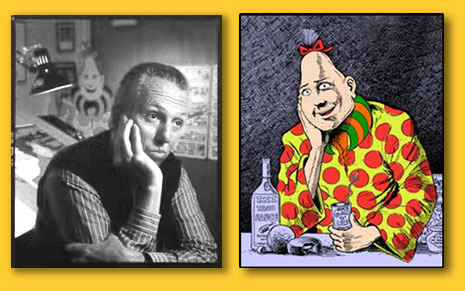|
A BILL GRIFFITH BIO
"Are we having fun yet?" This non sequitur utterance by the clown-suited
philosopher/media star Zippy the Pinhead has become so oft-quoted that
it is now in Bartlett's Familiar Quotations. Zippy has in fact become an
international icon, even appearing on the (former) Berlin Wall. Zippy's
creator, Bill Griffith, began his comics career in New York City in 1969.
His first strips were published in the East Village Other and Screw
Magazine and featured an angry amphibian named Mr. The Toad.
He ventured to San Francisco in 1970 to join the burgeoning underground
comics movement and made his home there until 1998. His first major
comic book titles included Tales of Toad and Young Lust, a best-selling
series parodying romance comics of the time.He was co-editor of Arcade,
The Comics Revue for its seven issue run in the mid-70s and worked with
the important underground publishers throughout the seventies and up to
the present: Print Mint, Last Gasp, Rip Off Press, Kitchen Sink and
Fantagraphics Books. The first Zippy strip appeared in Real Pulp #1
(Print Mint) in 1970. The strip went weekly in 1976, first in the Berkeley Barb
and then syndicated nationally through Rip Off Press.
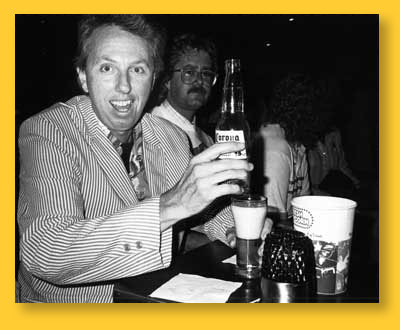
In 1980 weekly syndication was taken over by Zipsynd (later Pinhead Productions),
owned and operated by the artist. Zippy also appeared in the pages of the National
Lampoon and High Times from 1977 to 1984. In 1985 the San Francisco Examiner
asked Griffith to do Zippy six days a week, and in 1986 he was approached by
King Features Syndicate to take the daily strip to a national audience.Sunday
color strips began running in 1990. Today Zippy appears in over 200 newspapers
worldwide. There have been over a dozen paperback collections of Griffith's work
and numerous comic book and magazine appearances, both here and abroad.
He became an irregular contributor to The New Yorker in 1994. Griffith's inspiration
for Zippy came from several sources, among them the sideshow "pinheads" in
Tod Browning's 1932 film Freaks. The name "Zippy" springs from "Zip the What-Is-It?"
a "freak" exhibited by P.T. Barnum from 1864 to 1926. Zip's real name was
William Henry Jackson (below), born in 1842. Coincidentally, Griffith (as he discovered in
1975, five years after creating Zippy) bears the same name. He was born
William Henry Jackson Griffith (in 1944), named after his great-grandfather,
well-known photographer of the Old West William H. Jackson (1842-1941).
He is the author of four graphic novels: "Invisible Ink" (Fantagraphics Books, 2015), "Nobody's Fool" (Abrams ComicArts, 2019),
"Three Rocks" (Abrams ComicArts, 2023) and "Photographic Memory" ( Abrams ComicArts, 2025).
He is the recipient of the National Cartoonists Society's Reuben Award for Outstanding Cartoonist of the Year in 2022 and was
inducted into the Harvey Awards Hall of Fame in 2022.
Griffith presently lives and works in East Haddam, Connecticut.
Photo below from 1985. Griffith shown with longtime Zippy stand-in Ron Brannan.
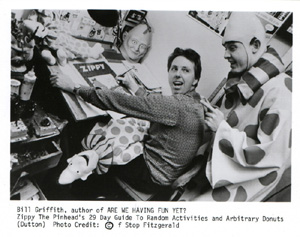
Below: Griffith's illustrious Great-Grandfather, William Henry Jackson,
at the Treasure Island World's Fair in San Francisco, 1939 (age 97).
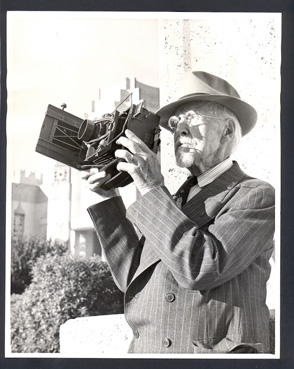
Below: Bill Griffith in his studio, May 31, 2008.
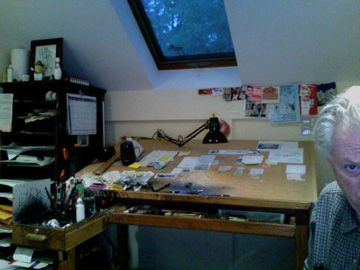
ANOTHER BILL GRIFFITH BIO (from "Current Biography", 2001)
Zippy the Pinhead, a comic strip by the cartoonist Bill
Griffith, features a demented microcephalic in a polka-dotted muumuu who
spouts surreal aphorisms. The strip is, according to some, a
delightfully bizarre social commentary; it appears daily in more than
200 newspapers nationwide, including the San Francisco Chronicle, the
Washington Post, and the Boston Globe. Griffith's strips are collected
in the Zippy Quarterly, as well as a number of books, including Kingpin,
Zippy's House of Fun. His work has also been reprinted in German,
French, Swedish, Italian, Japanese, Dutch, Finnish, and Spanish, and it
has been featured in the New Yorker, National Lampoon, and various
comics magazines, such as Arcade, Yow, and Weirdo. Griffith, a member of
the San Francisco underground art scene, appeared in John O'Hagan's 1997
documentary Wonderland, a hilarious look at the suburban development in
Levittown, Long Island, where the cartoonist was raised. Zippy has been
the subject of at least two doctoral dissertations and has also been
cited as the inspiration for Saturday Night Live's popular recurring
characters the Coneheads. "A lot of people write angry letters saying
Zippy is stupid," Griffith told Mark Anderson for the Monthly (February
2000). "And that's why they don't get it: because it is stupid."
Initially referred to as Danny, Zippy is a microcephalic clown
based in part on the "pinheads" who appeared in Tod Browning's classic
1932 horror film, Freaks. In addition to the uncommon shape of their
heads, microcephalics are known for their childlike personalities and
rapid-fire speech. "Their scrambled attention spans struck me as a
metaphor for the way we get our doses of reality these days," Griffith
told Jon Randall and Wesley Joost for an interview in Goblin Magazine
that was reprinted on Zippy the Pinhead's official home page. "The kind
of fractured, short term information overload that we're all exposed to
every day." Griffith was also inspired by old posters of Zip the
What-Is-It?, an actual microcephalic who was featured in the Barnum &
Bailey sideshow from 1864 to 1926. (In 1975 Griffith became aware of a
remarkable coincidence--he and Zip the What-Is-It? shared the same name.
Griffith was named William Henry Jackson after his great-grandfather,
the old West photographer William H. Jackson; Zip the What-Is-It? was
born William Henry Jackson, in 1842.)
Griffith also had the good fortune to meet Dooley, an actual
"pinhead" whom a friend in Connecticut drove to work every day. The
cartoonist took notes as Dooley explained why Walter Cronkite was God
and uttered a dizzying stream of non sequiturs such as "Are you still an
alcoholic?" Similarly, Zippy responds to most situations with seemingly
out-of-context phrases including: "I just accepted provolone into my
life," "I just became one with my browser software," "Frivolity is a
stern taskmaster," and "All life is a blur of Republicans and meat."
Although several people, including the comedienne Carol Burnett, claimed
to have created it, the phrase "Are we having fun yet?" was in fact
first uttered by Zippy in the mid-70s and has been immortalized in
Bartlett's Familiar Quotations. "It is an expression of the American
existential dilemma, of anxiousness," Griffith explained to John
Marshall for the Seattle Post-Intelligencer (July 1, 1992). "The phrase
is supposed to be satirical, but lots of people don't see the subtext."
Griffith tolerated the line's appearance on countless bootleg T-shirts
and bumper stickers, but was particularly disturbed when it began to be
repeated by such mainstream cartoon characters as Garfield, Dennis the
Menace, and Ziggy.
Griffith described Zippy to Carolyn Baptista for the New York
Times (July 11, 1999) as a "walking subconscious." Zippy behaves like a
Zen master engaged in a gleeful exploration of pop culture. "Zippy is
living in the moment," Griffith explained to Baptista. "He's at peace
with himself because he's out of step with everyone; he doesn't know it,
and he doesn't care. . . . Zippy has no problem with the irrationality
of the universe, whereas most of us are desperately trying to make order
out of the universe, and our lives. Zippy accepts chaos as what it is,
which is the real order of everything." Zippy enjoys ding dongs and
taco sauce, and can often be found meditating about the washer at his
local laundromat. Most strips consist of a dialogue between Zippy and
Griffy, the cartoonist's neurotic alter ego, a judgmental type who
comments on the inescapable vapidity of consumer culture. In a
conversation with Gary Groth for the Comics Journal (March 1993),
Griffith described their relationship as the "manifestation of an inner
dialogue" between "the critic and the fool." "I think Zippy is part of
me, but I'm not Zippy. Whereas I'm more Griffy than I am not Griffy. . .
. Without that dialogue, the strip would probably sink into surrealism,
or, in Griffy's case, mere ranting and raving." Other characters include
the lovesick barroom philosopher Claude Funston; Zippy's wife, Zerbina;
and their children, Fuelrod and Meltdown.
Although he admires the work of many of his contemporaries,
including Ben Katchor, Matt Groening, and Mike Judge, Griffith has often
lamented the dumbing down of popular comic strips. He longs for the days
when newspapers printed graphically compelling and well-written stories,
such as Chester Gould's Dick Tracy and George Herriman's Krazy Kat. In
an article celebrating the 100th anniversary of the comic strip, which
appeared in the Boston Globe on November 10, 1996 and was reprinted on
Zippy's home page, Griffith explained that the shrinking space allotted
for comics has led to a dulling of certain artists' ambitions. "In this
Darwinian set-up, what thrives are simply drawn panels, minimal
dialogue, and a lot of head-and-shoulder shots. Anything more
complicated is deemed 'too hard to read.' A full, rich drawing style is
a drawback. Simplicity, even crudity, rules. . . . What we're left with
is a kind of childish, depleted shell of a once-vibrant medium. Comics
is a language. It's a language most people understand intuitively. If
cartoonists use a large and varied 'vocabulary' to entertain their
readers, those readers will usually come along for the ride."
Bill Griffith was born on January 20, 1944 in the New York City
borough of Brooklyn. He became interested in comics as a boy, reading
MAD magazine and following the adventures of Uncle Scrooge, Little Lulu,
and Plastic Man, but abandoned them for fine art in his teenage years.
His father was a career army man, whom Griffith described to Jon Randall
and Wesley Joost as a "completely frustrated, miserable human being";
his mother was a science-fiction writer who later wrote for True
Confessions. "She encouraged any artistic impulse I had, and my father
discouraged any artistic impulse I had," Griffith recalled to Randall
and Joost. "I had a very diametrically opposite set of parents," he told
Gary Groth. "Very understanding, hip, smart, creative mother, and a very
authoritarian, screwed-up, angry father." Encouraged along with many
other World War II veterans to retire, Griffith's father left the army;
he later reluctantly accepted a demotion to return to military service
as an ROTC instructor.
In 1955 Griffith's family moved to a ranch house in Levittown,
New York, where scores of identical homes had been quickly constructed
for World War II veterans by the developer William Levitt. "I always
thought of Levittown as a joke," he told Keith Bearden for Lowest Common
Denominator (Summer 1999), a print and on-line magazine from the
producers of the New Jersey radio station WFMU. "But it wasn't a joke to
my parents. Levittown was a dream come true. They never thought in a
million years they'd ever be able to own a house. But if you were a GI,
coming back from the war--no money down. Unfortunately what came out of
it was also kind of an imitation community with a lot of mindless
conformity." Griffith found the atmosphere of 1950s suburban America
stifling. "There was a deep sense of absurdity in Levittown, this kind
of self-conscious striving to be the ideal suburb, the ideal American
Leave-It-to-Beaver-Land," he was quoted as saying by Manuel Mendoza in
the Dallas Morning News (July 7, 1997, on-line). "It had kind of a stage
set quality to me, like we were all acting out some kind of TV sitcom
and everybody was reading lines and there was a laugh track in the
background."
Griffith took solace in his developing friendship with one
Levittown neighbor, the illustrator Ed Emshwiller, who designed covers
for many science-fiction and mystery books and magazines. "He didn't
point me to cartooning, but he pointed me into art in general and showed
me a way of understanding how within one artist, there could exist this
pop culture impulse and a fine art impulse," Griffith told Gary Groth.
Emshwiller recruited Griffith's parents as models on several occasions,
but Griffith was most proud when he himself appeared on the cover of the
September 1957 issue of Original Science Fiction. Emshwiller depicted
the 13-year-old Griffith riding a rocket ship to the moon as his father
yelled at him from a video screen. Griffith first encountered the
bohemian utopia that was Greenwich Village when he accompanied
Emshwiller into New York City for film screenings at Cinema 16, an
experimental film group that counted Emshwiller among its members. At 16
Griffith had a few poems published in local literary journals and
attended performances by Allen Ginsberg and Bob Dylan. (In 1978 Griffith
chronicled his years living next door to Emshwiller in a strip entitled
"Is There Life After Levittown?")
Hoping "to become Jackson Pollock Jr." as he put it to Carolyn
Baptista, Griffith studied fine art at the Pratt Institute of
Technology, in Brooklyn. He met cartoonist Kim Deitch, who introduced
him to such work as Little Nemo and Krazy Kat. Griffith was soon drawn
to the counterculture comics of R. Crumb and others, and he began to
draw again. "My first character was Mr. Toad," he told The World
Encyclopedia of Comics (1999), "a mean-spirited amphibian dressed in a
tight-fitting tweed suit." Mr. Toad appeared in such underground
magazines as Screw and the East Village Other. (It was not until 1992,
while working on a series about his father, that the cartoonist realized
that his father had been the inspiration for Mr. Toad.) Griffith told
Baptista that from the moment that he published his first comic strip,
"the wise guy inside me triumphed over the artiste. Of course it took me
years and years to realize that it was a demanding craft." In 1970
Griffith moved to San Francisco, which had become a haven for
underground artists. Shortly after arriving, he created Young Lust, a
parody of 1950s romance comics that featured the adventures of Randy and
Cherisse, shopping-mall dwellers who spent a lot of time in therapy; the
series was published in 1970.
Zippy the Pinhead made his debut in a strip entitled "I Gave My
Heart to a Pinhead and He Made a Fool Out of Me," in the first issue of
Real Pulp Comics, in 1970. Zippy began as a comic foil for Mr. Toad but
quickly superseded the egocentric amphibian. By 1976 Griffith's strips
ran weekly in the Berkeley Barb, and his work also appeared in High
Times. Arcade was a short-lived magazine that he co-edited with Art
Spiegelman, a cartoonist now well known for Maus, his two-volume
Pulitzer Prize-winning comic strip about the Holocaust. From 1973 to
1974, Griffith also worked with Spiegelman on Topps' Wacky Packages,
trading cards with parodies of everyday supermarket products. From 1976
to 1980 he syndicated Zippy through Rip Off Press, a publisher of
predominately underground comics; for the next six years, he syndicated
the strip himself. For three years, beginning in 1977, Griffith created
Griffith Observatory, a satiric look at the people and places he
encountered in his daily life.
In 1985 William Hearst III took over the San Francisco Examiner,
hiring both Griffith and the gonzo journalist Hunter S. Thompson. The
following year Zippy the Pinhead was picked up for syndication by King
Features. Griffith never imagined that he would have the opportunity to
create a daily strip; he later discovered that the person who had
brought the strip to King Features had been unhappy with his job and
intended to use its acquisition as a form of revenge. "He told me he
took Zippy because to him, Zippy was like leaving a ticking time bomb on
the doorstep of King Features," Griffith told Gary Groth. "Plus he was a
big Zippy fan. So he was indulging his taste, and thumbing his nose at
his boss as he left."
In October 1994 Griffith toured Cuba for two weeks, traveling on
a cultural-exchange visa, one of the only legal ways to circumvent the
United States' ban on commerce with that nation. He arrived during the
final days of a mass exodus, as thousands took advantage of Castro's
decision to permit emigration for a limited time and left the island on
rafts. Griffith's detailed observations of Cuban culture and politics
were published in a six-week series of strips during early 1995. In the
strips, in a style Griffith has called "cartoon-o-journalism," Zippy's
observations were combined with verbatim transcripts of conversations
Griffith had conducted with various Cubans, including artists,
government officials, and a Yoruba priestess.
In October 1998 Griffith and his wife, the cartoonist Diane
Noomin, left San Francisco, as chain stores such as Starbucks began to
proliferate and the character of the city changed. They moved to East
Haddam, Connecticut, a picturesque town on the banks of the Connecticut
River. Griffith's strips have always had a diarylike quality, and
Connecticut has provided the artist with plenty of material. "In a movie
theater a few days ago, I go to the candy counter, and there's this huge
menu--candy, popcorn, ice cream, pickles," he told Carolyn Baptista.
"They're selling individual pickles. How does this happen? Where am I?
So of course I came home and did a Zippy strip about it. It was too
surreal not too."
Griffith and Noomin have collaborated on nine drafts of a
screenplay for a live-action version of Zippy that has yet to be
produced. They have also attempted to develop an animated series. A
proposed series for the Showtime cable network came to naught because of
budget conflicts, and Griffith has turned down MTV twice because the
network insisted on owning the character.
Not everyone is amused by Zippy; editors frequently receive
angry letters from readers who find the strip incomprehensible.
"Suddenly, I'm talking to people in trailer camps in Memphis who say
Zippy promotes communism and masturbation," Griffith told James Kindall
for New York Newsday (December 11, 1988). Many are baffled by such
scenarios as the one in 1998 in which Zippy repeated the phrase
"Kaczynski Lewinsky Lipinski Lebowski" in four successive panels; its
publication inspired a number of e-mails from distressed readers. The
cartoonist told Mark K. Anderson that those who were confused by the
strip were most likely unfamiliar with jazz and therefore did not
"understand the musicality of language." Griffith believes that it is
the nature of satire to be limitless in scope, and that sometimes
readers just get lost. "I tend to just go all over the map; satire one
day, a surrealist gag the next and a political strip the day after
that," he explained to Kindall. "That's one of the reasons Zippy has
lasted so long. He can pretty much say or do what he wants. It's almost
like he has super powers, but all between his ears. He can't fly but he
can move pretty quickly on the ground." The strip can be ambiguous and
challenging and has often broached such heady subject matter as
existentialism and quantum physics. But Griffith has insisted that he
does not intend to be obscure. "I ask the audience to meet it halfway,"
he told Bob Andelman for Mr. Media (February 17, 1997, on-line). "As a
result, I'm self-limiting it to the audience it has. But the 200 papers
it's in are 185 more papers than I ever thought it would be in. So I'm
happy."
Griffith is acutely aware that his brand of satire is not in
great demand at present. "People are pretty complacent, but I think
we're headed for another big shakeup," he told Keith Bearden. "It's like
the '50s, where things were pretty bland, you also got Harvey Kurtzman
and Mad and the Beats. But the problem is that business and media [are]
incredibly savvy about co-opting rebellion at this point. They own it
before it ever has the chance to gel and mature into anything powerful
or threatening. It's to the point where you can convince a 30-year-old
that it's a form of individuality or rebellion to wear a logo or buy a
certain car."
Although Zippy's proclamations might seem incoherent at first,
Griffith maintains that most of what he says can be decoded with effort.
"He may be a pinhead," the cartoonist commented to James Kindall, "but
he's not without a point." Griffith sees Zippy's growing cult following
as a direct result of the American populace's shortened attention span.
"The greatest boon to Zippy has been the remote control devices on TV,"
he told Kindall. "Zippy's attention span is limited to a 15-second TV
commercial. I was doing Zippy way back when people were still having to
get up and change the channel. Their attention spans were shrinking but
it was still a stretch to get into Zippy's fast-paced, channel-changing
mentality. Now they're sitting there going click, click, click. I think
there's a price to pay when your brain cells get used to that all night
long. They're getting up to Zippy's speed."
--C.L.
Works by subject
Selected Books: Nation of Pinheads, 1982; Pointed Behavior,
1984; Zippy Stories, 1984; Pindemonium, 1986; Pinhead's Progress, 1989;
Get Me a Table Without Flies, Harry, 1990; From A to Zippy, 1991;
Griffith Observatory, 1993; Zippy's House of Fun, 1995; Zippy Annual,
2000
Works about subject
Suggested Reading: Comics Journal p50+ Mar. 1993, with photos;
Lowest Common Denominator p8+ Summer 1999; Monthly p5+ February 2000,
with photo; New York Times (Connecticut edition) p13 July 11, 1999, with
photo; Official Zippy the Pinhead home page; Seattle Post-Intelligencer
C p1+ July 1, 1992, with photo; Washington Post B p1 Apr. 8, 1995
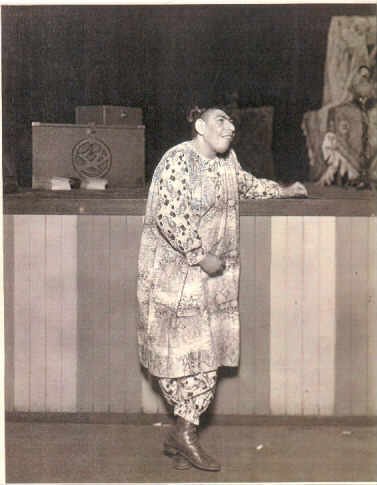
Above: "Schlitzie", a.k.a. "The Missing Link", "Monkey Girl" and "The Last Of The Incas",
born Simon Metz c. 1892. Died c. 1972. Had parts in two movies; "Freaks"
(1932, Tod Browning, dir.) and as "Princess Betsy" in "Meet Boston Blackie" (1941).
Shown here in a 1929 San Francisco press release.
BELOW: "Schlitzie" Zippy daily from 5/2/02. (NOTE: It was conformed recently
in an email from a reader who knew Schlitzie in his later years that Schlitzie was, indeed, a "he").
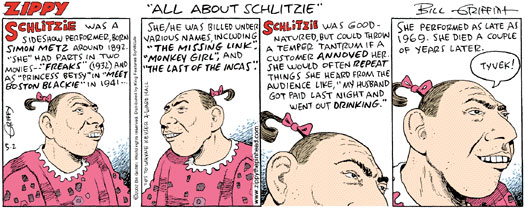
Below: Introduction to "Nancy Eats Food", 1989, Kitchen Sink Press
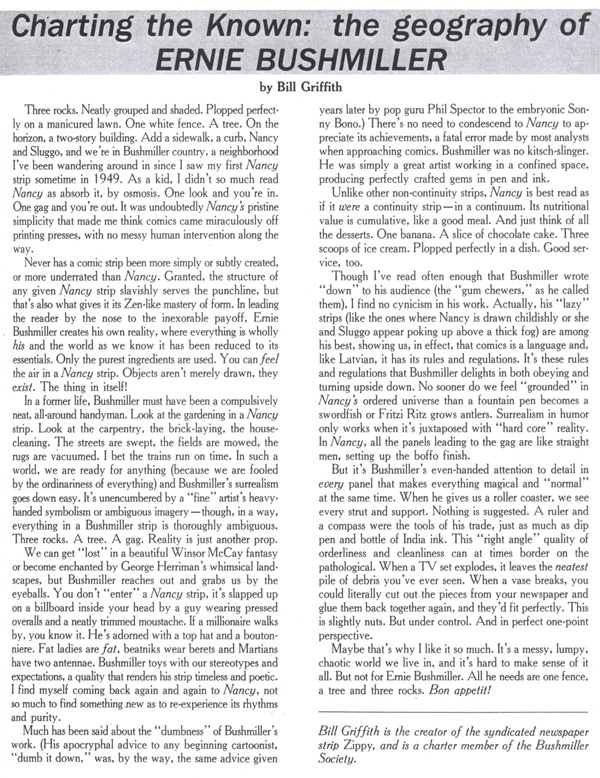
MORE BELOW
|


